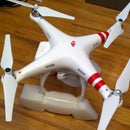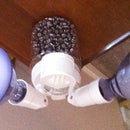Introduction: How to Clean the Controls on Your Amplifier
Is that crackling and popping when you turn the controls on your amp driving you crazy? Here's how to clean them and get back to the music.
There are spray "contact cleaners" available for this purpose, but in most cases just mixes the dirt and grime already inside with more dirt and assembly grease and may make the control operate worse than it is already.
There are spray "contact cleaners" available for this purpose, but in most cases just mixes the dirt and grime already inside with more dirt and assembly grease and may make the control operate worse than it is already.
Step 1: Remove Mounting Knobs and Nuts
The first step is to remove the knobs and nuts mounting the controls to the front panel to the amplifier. Remember to keep all the parts sorted so you can find them later.
Step 2: Unsolder the Controls
After the circuit board is removed from the amplifier box, each control is removed and cleaned one part at a time. Do not take them all off at the same time, because you may mix them up.
Step 3: Remove Old Solder
Remove old solder and inspect the pads for any burnt or broken traces.
Step 4: Open the Control
Open the control (potentiometer or "pot") by lifting the mounting tabs slightly. Remember that these tabs will not handle being bent more than a few times before they break off. If a tab breaks off, you may be able to solder it back on later.
Step 5: Inspect Dirty Contacts
The control is made up of two main parts. The contacts and the carbon resistor. Each side must be cleaned without damaging them further. If the carbon looks burnt or has broken areas, the entire control may need to be replaced. If the contacts are worn too much or broken, the entire control may need to be replaced.
Step 6: Cleaning
Carefully, clean the contacts and carbon with a pencil eraser. Do not push too hard, and clean the eraser on a piece of paper when it gets too dirty. Do not use any cleaner or solvent except rubbing alcohol or cleaner designated for this type of control. Make sure to blow off any eraser particles left on the control before assembling the part.
Step 7: Cleaning Continued
If you are cleaning a dual control, the method will be the same, however it will take twice as long, and you must align both controls so they go back together correctly.
Step 8: After Cleaning - Reassemble the Control
Being careful not to forget any parts, recrimp the case making sure not to bend the case or trap any parts between the case and the parts inside. Turn the control and check for a nice smooth motion from the 0 to 10 locations. The control should move approx. 120 degrees without any binding or bumps.
If you think you assembled one incorrectly, set it aside, and open the next one to look at how it should be assembled to fix the last one. If you need to, take pictures of each phase to help you reassemble the parts later.
Try not to get any grease or oil on the contacts while assembling the part. There may be some grease on other areas of the control, but it is not intended to be on the contacts. There is a special conductive grease that can be used on the contacts, but is not necessary for proper operation.
If you think you assembled one incorrectly, set it aside, and open the next one to look at how it should be assembled to fix the last one. If you need to, take pictures of each phase to help you reassemble the parts later.
Try not to get any grease or oil on the contacts while assembling the part. There may be some grease on other areas of the control, but it is not intended to be on the contacts. There is a special conductive grease that can be used on the contacts, but is not necessary for proper operation.
Step 9: Resolder and Continue Cleaning the Rest of the Controls
Use new solder to assemble the clean control back onto the PCB. Clean the solder flux off with some rubbing alcohol or flux remover.
Step 10: Finish and Test
Put the PCB back into the cabinet, and test the amplifier. Turn each control and make sure it works as it should.
That's all folks, enjoy your "good-as-new" amp.
It took me about 2 hour to clean this Peavy, so at a tech rate of $60 per hour, I saved a bunch of cash doing it myself.
That's all folks, enjoy your "good-as-new" amp.
It took me about 2 hour to clean this Peavy, so at a tech rate of $60 per hour, I saved a bunch of cash doing it myself.





